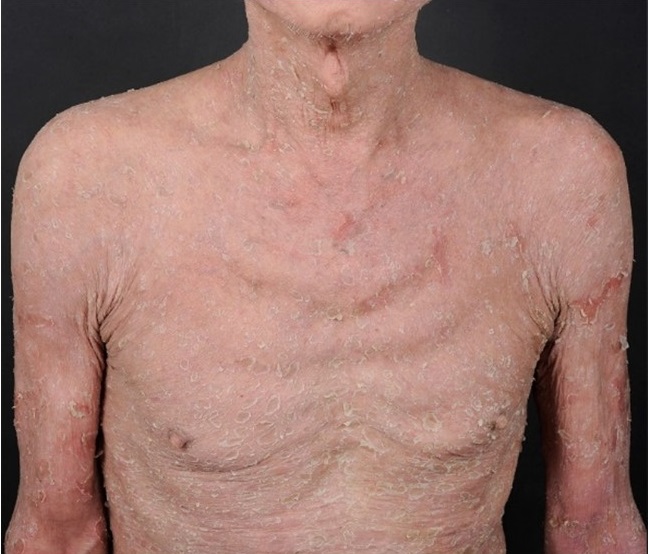Pemphigus Foliaceus, An Uncommon Presentation with Erythroderma: A Case Report
Keywords:
Pemphigus Foliaceus, ErythrodermaAbstract
Pemphigus foliaceus (PF) is an autoimmune blistering disease, which is typically characterized by scaly, crusted skin lesions and flaccid blisters that can evolve into cutaneous erosion, distributed to the seborrheic areas of the scalp, face, and trunk, but lacking mucosal involvement. Exfoliative erythroderma is an uncommon feature of PF that tends to resist conventional treatment, such as corticosteroids. We report the case of a 69-year-old man who presented with exfoliative dermatitis and ectropion both eyes. An incisional skin biopsy was done at the left forearm revealing subcorneal separation with acantholytic keratinocytes and direct immunofluorescence consistent with PF.
The patient was treated with two infusions of 1 gram rituximab two weeks apart accompanied by 30 mg oral prednisolone daily. After rituximab infusion, significant clinical improvement was observed. Rituximab is an alternative treatment for moderate to severe PF, including exfoliative PF, and leads to clinical improvement.
References
James KA, Culton DA, Diaz LA. Diagnosis and clinical features of pemphigus foliaceus. Dermatol Clin 2011;29:405-12.
Kneisel A, Hertl M. Autoimmune bullous skin diseases. Part 1: Clinical manifestations. J Dtsch Dermatol Ges 2011;9:844-56;quiz 57.
Pal S, Haroon TS. Erythroderma: a clinico-etiologic study of 90 cases. Int J Dermatol 1998;37:104-7.
Grekin SJ, Fox MC, Gudjonsson JE, Fullen DR. Psoriasiform pemphigus foliaceus: a report of two cases. J Cutan Pathol 2012;39:549-53.
Murrell DF, Peña S, Joly P, et al. Diagnosis and management of pemphigus: Recommendations of an international panel of experts. J Am Acad Dermatol 2020;82:575-85.e1.
Joly P, Horvath B, Patsatsi A, et al. Updated S2K guidelines on the management of pemphigus vulgaris and foliaceus initiated by the european academy of dermatology and venereology (EADV). J Eur Acad Dermatol Venereol 2020;34:1900-13.
de Sena Nogueira Maehara L, Huizinga J, Jonkman MF. Rituximab therapy in pemphigus foliaceus: report of 12 cases and review of recent literature. Br J Dermatol 2015;172:1420-3.
Hacker MK, Janson M, Fairley JA, Lin MS. Isotypes and antigenic profiles of pemphigus foliaceus and pemphigus vulgaris autoantibodies. Clin Immunol 2002;105:64-74.
Miyamoto D, Sotto MN, Otani CS, et al. Increased serum levels of vascular endothelial growth factor in pemphigus foliaceus patients with erythroderma. J Eur Acad Dermatol Venereol 2017;31:333-6.
Gea-Banacloche JC. Rituximab-associated infections. Semin Hematol 2010;47:187-98.

Downloads
Published
How to Cite
Issue
Section
License
Copyright (c) 2023 Thai Journal of Dermatology

This work is licensed under a Creative Commons Attribution-NonCommercial-NoDerivatives 4.0 International License.
เนื้อหาและข้อมูลในบทความที่ลงตีพิมพ์ในวารสารโรคผิวหนัง ถือเป็นข้อคิดเห็นและความรับผิดชอบของผู้เขียนบทความโดยตรงซึ่งกองบรรณาธิการวารสาร ไม่จำเป็นต้องเห็นด้วย หรือร่วมรับผิดชอบใดๆ
บทความ ข้อมูล เนื้อหา รูปภาพ ฯลฯ ที่ได้รับการตีพิมพ์ในวารสารโรคผิวหนัง ถือเป็นลิขสิทธิ์ของวารสารฯ หากบุคคลหรือหน่วยงานใดต้องการนำทั้งหมดหรือส่วนหนึ่งส่วนใดไปเผยแพร่ต่อหรือเพื่อกระทำการใดๆ จะต้องได้รับอนุญาตเป็นลายลักอักษรจากบรรณาธิการวารสารโรคผิวหนังก่อนเท่านั้น


